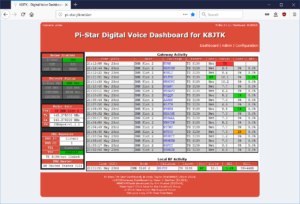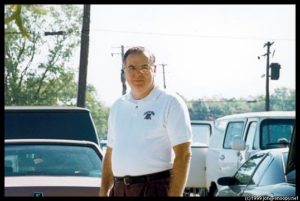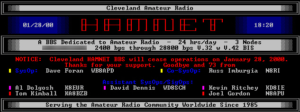One of the responsibilities of the Technical Coordinator in the Ohio Section is to submit something for the Section Journal. The Section Journal covers Amateur Radio related things happening in and around the ARRL Ohio Section. It is published by the Section Manager Scott – N8SY and articles are submitted by cabinet members.
Once my article is published in the Journal, I will also make it available on my site with a link to the published edition.
You can receive the Journal and other Ohio Section news by joining the mailing list Scott has setup. You do not need to be a member of the ARRL, Ohio Section, or even a ham to join the mailing list. Please sign up!
If you are an ARRL member and reside in the Ohio Section, update your mailing preferences to receive Ohio Section news in your inbox. Those residing outside the section will need to use the mailing list link above.
Updating your ARRL profile will deliver news from the section where you reside (if the leadership chooses to use this method).
Go to www.arrl.org and logon.
Click Edit your Profile.
You will be taken to the Edit Your Profile page. On the first tab Edit Info, verify your Email address is correct.
Click the Edit Email Subscriptions tab.
Check the News and information from your Division Director and Section Manager box.
Click Save.
Now without further ado…
Read the full edition at:
THE TECHNICAL COORDINATOR
Jeff Kopcak – TC
k8jtk@arrl.net
I received a question last month from Andy – KD8SCV on setting up a digital hotspot transmit frequency compliant with “Line A.” I’ll address these as two separate issues. If the hotspot or simplex node is within the correct ranges of the band plan, Line A doesn’t matter. You’re going to need your copy of Part 97.
What is Line A? It is an approximate border between the U.S. and Canada that varies in exact location but is most often 75 miles (about 121 km) from the border. According to Part 97.3(a):
(30) Line A. Begins at Aberdeen, WA, running by great circle arc to the intersection of 48° N, 120° W, thence along parallel 48° N, to the intersection of 95° W, thence by great circle arc through the southernmost point of Duluth, MN, thence by great circle arc to 45° N, 85° W, thence southward along meridian 85° W, to its intersection with parallel 41° N, thence along parallel 41° N, to its intersection with meridian 82° W, thence by great circle arc through the southernmost point of Bangor, ME, thence by great circle arc through the southernmost point of Searsport, ME, at which point it terminates.
This is the same wording as Title 47 of the Code of Federal Regulations (CFR), Section 90.7. Doesn’t tell you much, like why does it exist? This information is a little sparse. Possibly to protect land mobile stations in Canada. Land Mobile Service (or LMS) is defined by the ITU as communications between base stations and mobile stations or between mobile stations. Think public service agencies and even private companies to coordinate people, resources, safety, or security. Amateur Radio is allocated secondary status on most U.S. allocations above 1.25m or the 220 MHz band. 420-450 MHz is shared with federal agencies and military for radar applications such as PARCS located in North Dakota near the Canadian border. As it pertains to the Amateur Radio service:
(1) No amateur station shall transmit from north of Line A in the 420-430 MHz segment. See §97.3(a) for the definition of Line A (Part 97.303(m)).

For stations in the western part of the state north of 41° N, no transmissions between 420-430 MHz can be made. This includes the cities of Ottawa, Findlay, Tiffin, Willard, New London, and Lodi. Close to the intersection of State Route 83 and Interstate 71, near the cities of Lodi in Medina county and Burbank in Wayne county, is where 41° N and 82° W intersect. From that location, Line A takes a northeast trajectory to Bangor, ME. North of Line A constitutes Medina, much of the Cuyahoga Valley, Hudson, bisects Streetsboro and Mantua, Hiram, West Farmington, North Bloomfield, and Andover.
For those wondering, there is a Line B, Line C, and Line D. In Canada, Line B is opposite to Line A while Line C and D divide the Alaskan border with Canada. There is no mention of Line C in Part 97. Land mobile stations licensed north of Line A or east of Line C requires additional coordination with Canadian authorities.
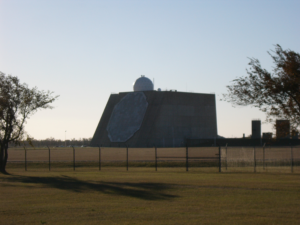
The FCC has provided a couple resources that depict Line A and check Line A coordinates. The checking site won’t accept Google Maps coordinate format. It requires NAD83. I found a converter that worked well. On a Google Map, left-click until a small gray marker appears on the map. Coordinates will appear in a pop-up in the lower-center of the map. 41.460459, -81.911875 for example. Copy them. Go to the West Virginia coordinate conversion website. Paste them under “Input Coordinates.” “Lat/Lon WGS 1984” should already be selected. Under “Output Coordinates,” select “Lat/Lon NAD83.” Click Covert. Copy the output coordinates (removing the negative symbol and spaces) into the FCC Line A check site. Example Lat: 412737.6, Lon: 815442.7. The site will return “North of Line A” or “South of Line A” for the relative location.
As a general rule, don’t transmit 420-430 MHz within 80 miles from the Canadian border and you’ll be golden.
For everyone, the following applies in Part 97.303(m):
(2) Amateur stations transmitting in the 420-430 MHz segment must not cause harmful interference to, and must accept interference from, stations authorized by the FCC in the land mobile service within 80.5 km of Buffalo, Cleveland, and Detroit. See §2.106, footnote US230 for specific frequencies and coordinates. (3) Amateur stations transmitting in the 420-430 MHz segment or the 440-450 MHz segment must not cause harmful interference to, and must accept interference from, stations authorized by other nations in the fixed and mobile except aeronautical mobile services.
80.5 km is a little more than 50 mi. Check the FCC or Radio Reference sites for issued licenses between 420 and 430 MHz in Ohio. Many licenses are assigned in the Cleveland and Toledo areas.
My OSJ article last year, though pertaining to hotspots and satellites, addressed the hotspot frequency question nicely. I’ll reiterate because this is important. Under Part 97, hotspot devices are considered an auxiliary station. In general, advice would be to ‘check with the local frequency coordinator’ but experience with the coordinating group indicates they won’t be of any help. Where should you operate a digital hotspot or digital simplex node? I do like the ARRL’s Band Plan because it spells out many details not included in graphical representations. Note: this advice only applies to the U.S. band plan. The band plan has allowances in the following frequency ranges for simplex, auxiliary stations and control links:
- 146.400 – 146.580. Usable (at 12.5 KHz spacing): 146.4125 – 146.5675
- 433.000 – 435.000. Usable (at 12.5 KHz spacing): 433.0125 – 434.9875
- 445.000 – 447.000. Usable (at 12.5 KHz spacing): 445.0125 – 446.9875
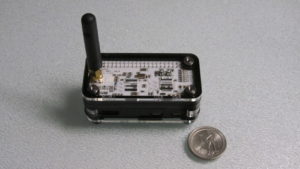
“Usable” indicates the lower and upper frequency limits that can be used and programmed into a digital hotspot. Don’t forget to stay away from the national calling frequencies of 146.520 and 446.000. Some of these ranges are shared with repeater links so remember: it is your responsibility to ensure correct operation of your equipment and find a frequency not already in use before using it! There is NO excuse for not adjusting frequency to eliminate interference with other operators and equipment! Listen to the desired frequency by setting up a radio or scanner with the volume turned up. If you hear any kind of obvious traffic, data bursts, or digital screeching, pick another frequency then rinse and repeat. Notice none of these allowances include frequency restrictions imposed by Line A.
Every hotspot user and repeater owner reading this needs to verify your operating frequencies and take corrective action, if required. Auxiliary stations cannot operate within the satellite sub bands. Many hotspots are operating there illegally. Satellite sub bands for 2 & 440 are:
- 2 m: 145.800 – 146.000
- 70 cm: 435.000 – 438.000
If your hotspot is operating near edges where deviation would fall into an unauthorized band segment, operating “out-of-band” (ie: weak-signal, satellite), or operating 420-430 MHz and located “North of Line A”, you need to take corrective action now! Your cooperation is greatly appreciated!
Yahoo! Groups is going away! Since 2001, the service allowed users to “build relationships, stay in touch, share ideas, and discuss interests through the convenience of popular e-mail and Web-based tools.” Many ham radio groups over the years have used or are using Yahoo! Groups to coordinate and collaborate.
An SSTV Net in Cleveland used Yahoo! Groups to share received pictures and offer support for stations having trouble with their setup. It was the first time I used the service. Special interest groups formed on a wide variety of topics including scanner information, D-STAR, DMR, and System Fusion.
A note sent to users laid out the time line of the impending shutdown:
Beginning October 28 you won't be able to upload any more content to the site, and as of December 14 all previously posted content on the site will be permanently removed. You'll have until that date to save anything you've uploaded.
 Moving or saving data needs to happen relatively quickly should you or group members want to keep the information. Read this knowledge base article to understand the changes and information on how to save content from your groups. Steps don’t seem quick or easy.
Moving or saving data needs to happen relatively quickly should you or group members want to keep the information. Read this knowledge base article to understand the changes and information on how to save content from your groups. Steps don’t seem quick or easy.
An ARS Technica article provides more details on the shutdown. Citing a successful service with 110 million users in 2010, Yahoo failed to adequately compete in other areas after being acquired by Verizon. Verizon responded by cutting budgets and staff.
I mentioned Groups.io in July as a service I joined earlier this year to keep updated on different ham radio projects. Feedback has been positive and many are recommending it as a place to transition before the shutdown. Groups.io doesn’t serve ads, track users, and has a better reputation than Facebook, which I neither use nor trust. Featuring a modern platform for communities to connect through messaging, calendar, chat, polls, databases, photos, wiki, and integration with a list of other platforms. Great place for projects to post documentation and offer support or as a platform to keep in-touch with club members. Some indicated greater engagement with club members and more attendance.
A wiki article posted contains instructions for moving content to Groups.io. It indicates transfers need to be initiated before December 1, 2019 to guarantee the transfer of content from Yahoo! Groups to Groups.io – though Yahoo was having issues with Photos.
Last month, I was invited to give a presentation at the meeting of the Lake County Amateur Radio Association (LCARA). The presentation was about, well, me. I talk about my biography including schooling, how I got involved with groups, jobs, and other presentations I’ve put together. Most importantly, talk about the duties and responsibilities of the Ohio Section Technical Coordinator and technical resources available to hams in the Ohio Section. I had a great time as I don’t get out to Lake county often and it was a fantastic day for a drive. The club was very welcoming. LCARA has many members passionate about different aspects of the hobby and they report on each during their meeting. A good time was had by all.
If you would like to know more about the TC position within the Ohio Section or want to know more about the technical resources available in our section, contact myself or a Technical Specialist.
Thanks for reading and 73… de Jeff – K8JTK


